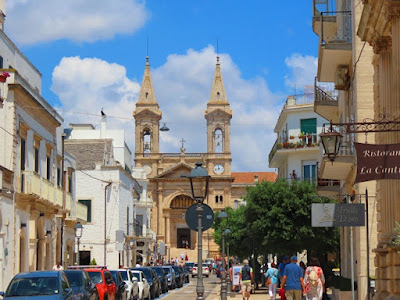Alberobello
Alberobello wins wows from everyone when seeing photo(s) of numerous trulli, white houses characterized by a conical stone roof. The whitewashed walls of the trulli are built directly onto limestone bedrock and constructed using a dry-stone wall technique (i.e., without use of mortar or cement). The roof structure sits directly on the walls using simple squinches (corner arches) allowing the transition from the rectangular wall structure to the circular or oval sections of the roofs. The roofs of buildings often bear mythological or religious markings in white ash and terminate in a decorative pinnacle whose purpose is to ward off evil influences or bad luck. Thousands of trulli are like fairy tale setup and felt mythical. They are unique in this world.
In the old days in Italy, there
was a tax on the rooftops. One had to pay this tax on the number of rooftops one
had got. People from Alberobello had contrived a trick. They started to build
their own houses with this conical roof made by stones wedged each other
without any glue or concrete. In this way, they could disassemble the roofs
anytime, especially when the tax inspector came. The Trulli then became unique
houses. Tourists flock to Alberobello every day, all year round.
We spent 6 nights in Bari and hop to nearby towns for day trips. To visit the fascinating Alberobello, we took an early coach to see its beauty when the sun was not high and to avoid tourist crowds. Make sure to purchase the coach ticket(s) in advance. Last minute purchase or show up may upset you as no more seat is available. This happens quite often.
The historical heart of Alberobello
is divided by the street “Largo Martellotta” in two zones: “Rione Monti” and
“Rione Aia Piccola”, both are recognized as Italian National Monument in 1910
and 1930. In 1996 the
uniqueness of the stratified landscape in Alberobello was recognized as a
UNESCO World Heritage Site.
Our visit started in Rione Aia
Piccola, the quieter and less touristic part of Alberobello. Around 400 trulli are
for residential use there. No shops or clubs but flowers and pots of plant
dotting the whitewashed houses. With blue sky and white clouds as the backdrop,
it’s amazingly beautiful.
There are two viewpoints to capture the beautiful Alberobello Trulli houses panorama. Both are located on the Rione Aia Piccola hill, Villa Comunale Belvedere and Fontana Santa Lucia. Breathtaking panorama of Alberobello awaited! Gorgeous! Just don’t be shy to ask visitors around to allow you to go front to capture the adorable scenes. Alternatively, walk up stairs of the same hill to enjoy the panorama with a lesser crowd. All above are free. It may be nicer than any rooftops in Rione Monti that one can ascend to after buying small stuff or souvenir at shops.
It was a pleasant leisure to walk here and there, without reading any tour book to guide us around or flock to those ‘must see’.
After admiring the humbly
charming Rione Aia Piccola, we proceeded to Rione Monti, with more than 1,000
trulli cascade down the hillside.
We walked through different lanes up and down in Rione Monti. Loads of shops. Salespersons were busy with selling. Tourists attempted to go up to rooftops for views of the conical stone roof around.
More tourists arrived. We
escaped by going upwards to the trullo church of St Anthony of Padua. It is a
trullo-topped church standing on the highest point of Rione Monti. The façade
is simply white with conical domes. Unique yet lovely. The construction started
from 1927, a rather young church.
At time, soldiers rehearsed changing
guards at the entrance of the trullo church. We could not visit it. From information available at internet: the
church follows a Greek cross floor plan, has stone arches and walls.
Around midday, the flocks of tourist became unbearable. Instead of staying in Alberobello to visit specific trulli, we headed towards the railway station for a visit to Locorontodo. Not far away from the railway station, there stands the Saints Cosma and Damian's Church, a monument with two bell towers which is dated back to 1885.
Some visitors opt to stay overnight in a trullo. It is an excellent experience and a way to see the night scenes after the day-tourists have gone. We remained overnight in Bari to save the troubles of moving luggage. However, the interior of our B&B in Polignano a Mare is that of trullo. Raw stone tile ceiling, old style floor tiles and great hospitality of our land lady made it a fantastic experience and memory in Polignano a Mare. In fact, trulli scatter here and there in Itria Valley. See if you prefer trullo overnight right in Alberobello or a bit away from the crowds.
























Comments